Planning a cooking class in Chiang Mai? This honest review covers our experience at a top-rated Thai cooking school – with tips, recipes, and local insight.
After a week of eating incredible street food (and getting slightly obsessed with pad thai), my partner and I knew we had to learn how to recreate these flavors back home in Poland.
We ended up at Thai Farm Cooking School – and honestly, it was one of those experiences that completely exceeded expectations.
Not just because we learned to make six different dishes, but because we got to understand Thai culture through food in a way that felt genuine, not touristy.
If you’re debating whether to book a cooking class in Chiang Mai, let me walk you through exactly what to expect.
Spoiler alert: you’re going to want to clear some space in your luggage for the cookbook they give you!
![Best Chiang Mai Cooking Class [2025]: Honest Review + Prices](https://runawayann.com/wp-content/uploads/2025/06/Cooking-Class-in-Chiang-Mai-14.jpg)
Why We Chose Thai Farm Cooking School
I’ll be honest – we picked Thai Farm Cooking School mostly because it was ranked #1 on TripAdvisor at the time. Sometimes the popular choice really is the right choice.
What sold me was reading that you get to visit an actual organic farm, not just cook in some sterile kitchen downtown.
For 1500 baht per person (about $45), you get the full day experience: market visit, farm tour, cooking lesson, all your food, drinks, and a cookbook to take home.
After experiencing it, I can see why it’s so highly rated. This isn’t just about learning recipes – it’s about understanding where Thai flavors actually come from.
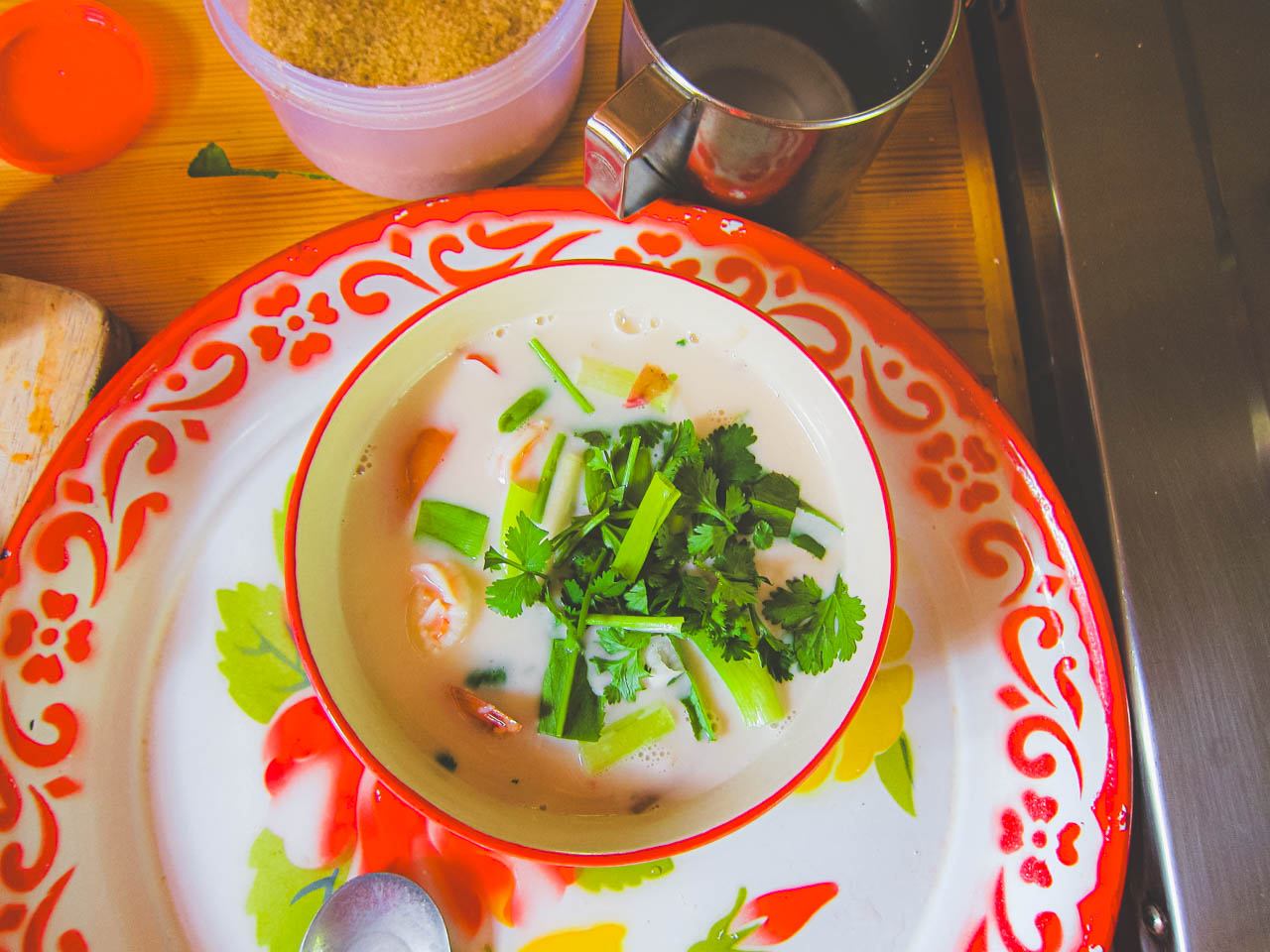
Thai Farm Cooking School vs. Other Chiang Mai Cooking Schools
| Feature / Experience | Thai Farm Cooking School | Other Popular Schools in Chiang Mai |
| Location | Organic farm outside the city, with mountain views | Mostly downtown kitchens or small gardens |
| Market Tour | Full guided visit to Ruamchook Market with ingredient explanations | Often a quick stop or no market visit |
| Farm Tour | Yes – pick your own herbs and vegetables | Rare – usually pre-prepared ingredients |
| Class Size | Small groups (max 12 people) | Can be up to 20+ in busy seasons |
| Menu Options | Choose your own curry, soup, stir-fry + dessert | Fixed menu for all participants |
| Recipes Included | 8 recipes in a printed cookbook | Some give PDFs or no recipes at all |
| Duration | Full day (8:30 AM – 5:00 PM) | Half-day or full-day options |
| Price (2025) | 1,500 THB (~$45) incl. all meals, drinks, transport, and recipes | 1,200-1,500 THB (may exclude transport or drinks) |
| Atmosphere | Relaxed, scenic, feels like cooking at a friend’s home | Can feel more like a formal class or tourist activity |
💡 If you’re looking for a full-day experience in nature with plenty of hands-on time and real local insight, Thai Farm Cooking School is hard to beat.
Our Market Adventure at Ruamchook
Our adventure started at Ruamchook Market, and I’ll be honest – I was a little nervous about the early pickup (8:30 AM is early for vacation!).
But our guide Yummy made it immediately clear this wasn’t going to be some rushed tourist experience.
She spent real time explaining why rice is so central to Thai culture – stuff you’d never learn just eating at restaurants.
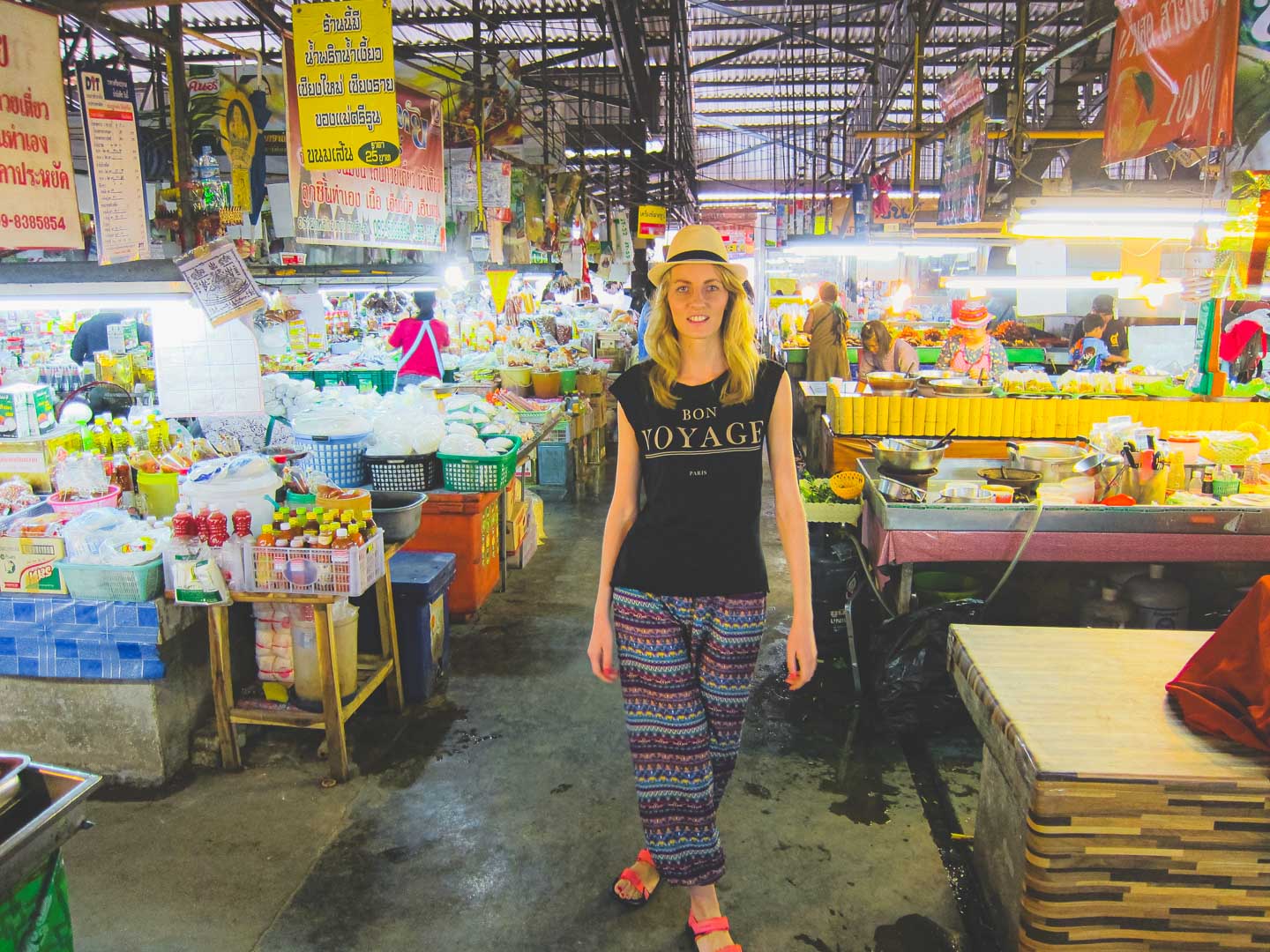
The coolest part? Learning how to make fresh coconut milk by hand. I always wondered how they got that creamy texture, and watching Yummy demonstrate with actual coconuts was kind of mesmerizing.
I spent way too much time taking photos of the spice stalls (they’re seriously Instagram-worthy), but the free time to wander around was perfect for getting a feel for how locals actually shop for ingredients.
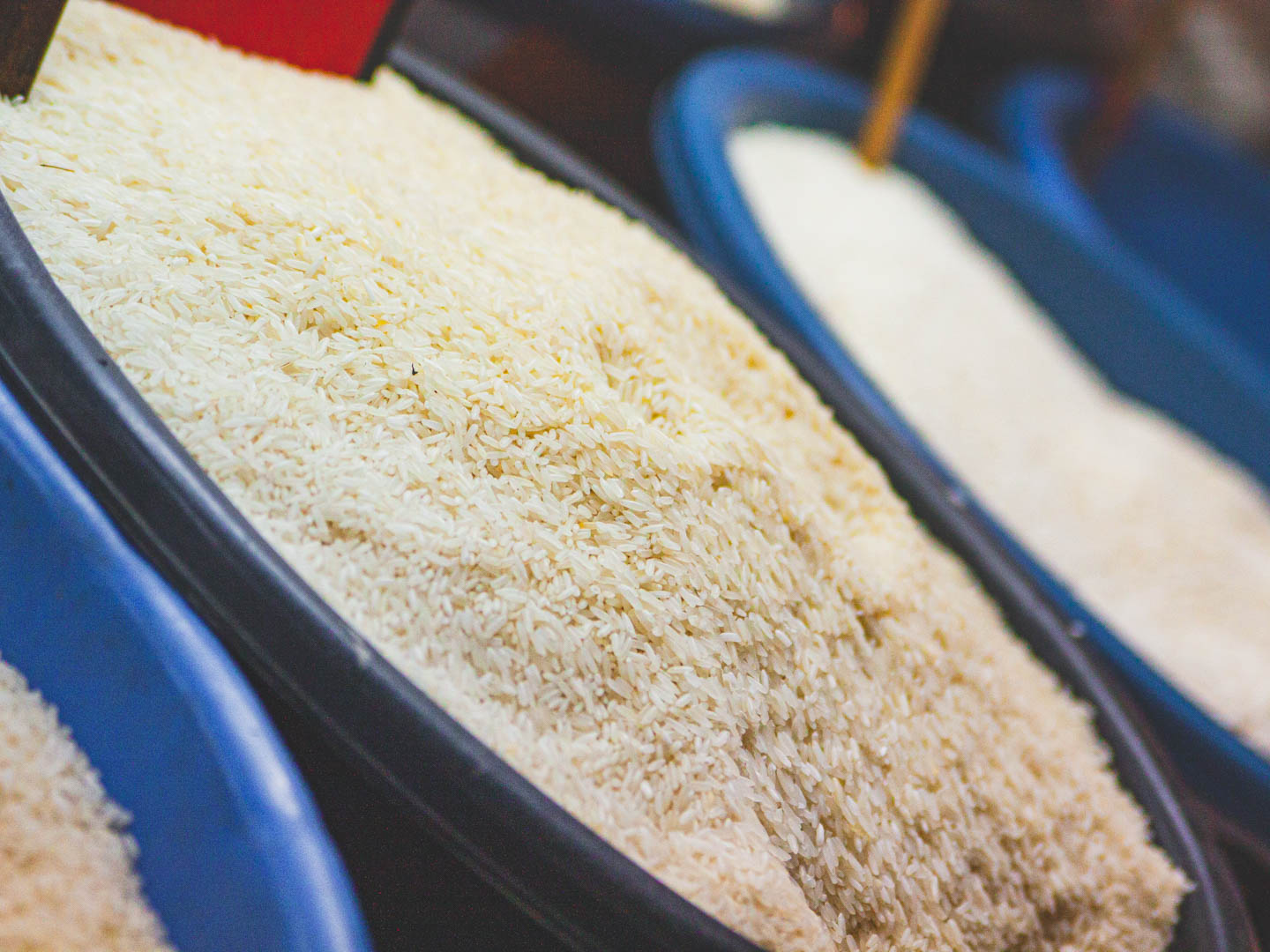
The Farm That Changed Everything
After the market, we hopped back on the bus to head to the actual farm, and this is where things got really special. I wasn’t expecting much from the “farm tour” part – figured it would be a quick walk around some plants.
But stepping off that bus felt like entering a different world. Mountains in the distance, peaceful pond, and the kind of quiet you don’t get in the city.
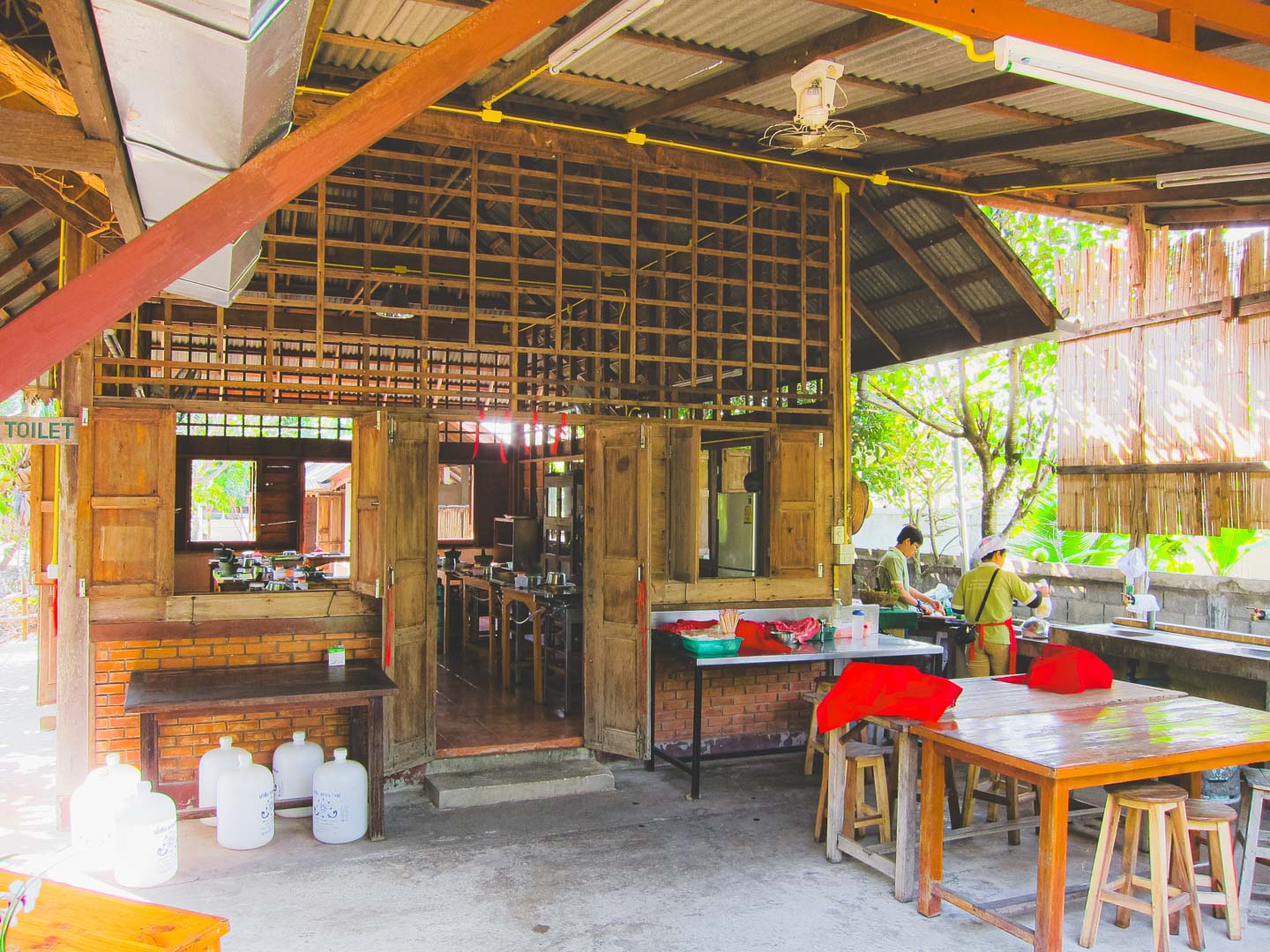
Our instructor Yummy walked us through their organic growing methods, and I was genuinely impressed. Everything grown without chemicals, and you could taste the difference in the herbs we picked straight from the ground.
The lemongrass was so fragrant it almost knocked me over, and seeing papaya growing on actual trees (not in a grocery store) was oddly exciting. Sometimes you forget where food actually comes from until you see it growing.
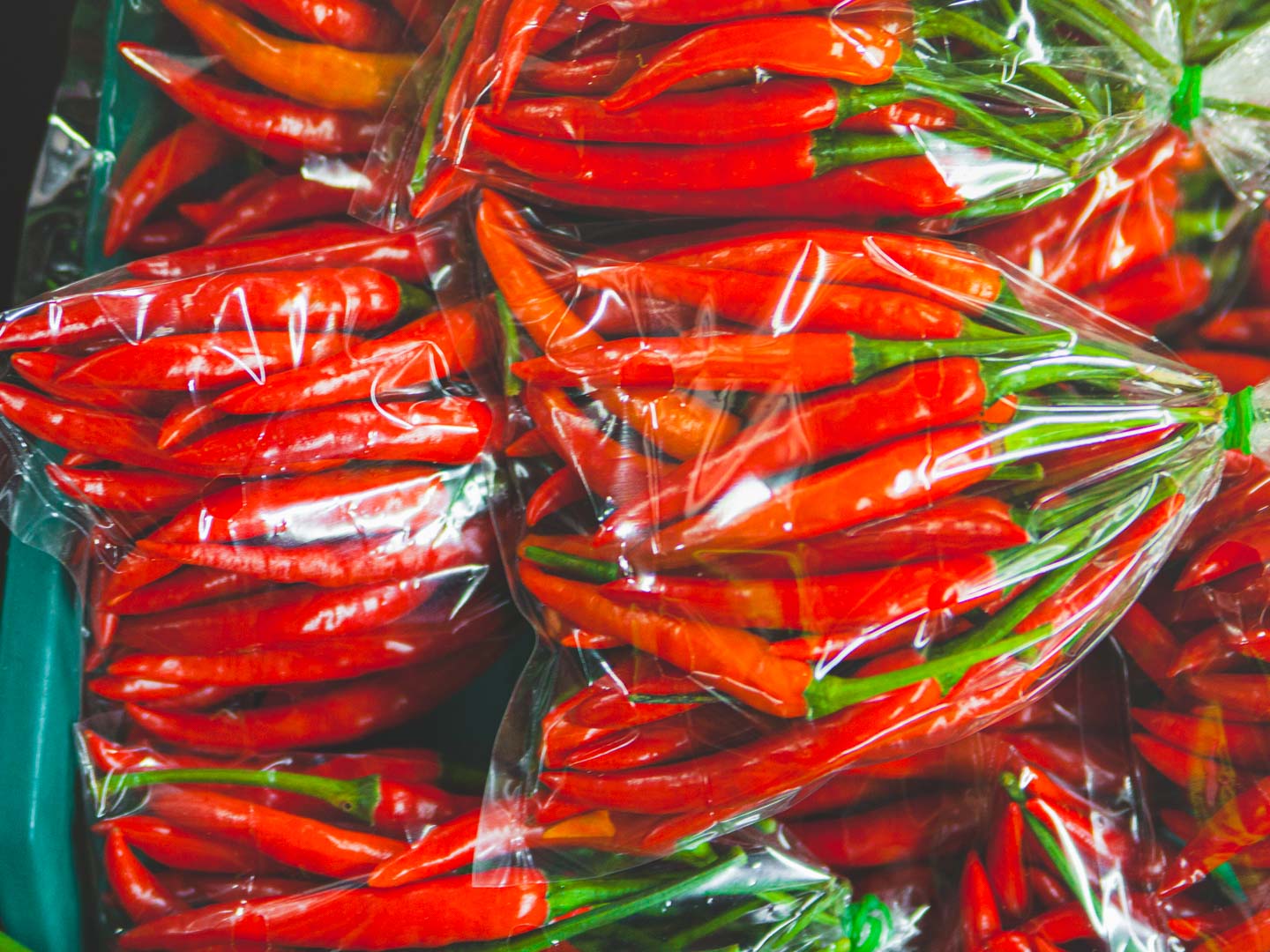
Want all the recipes from this cooking class?
I’m sharing the complete collection of 8 authentic Thai recipes we learned, with step-by-step instructions and my personal tips for making them at home.
Get your free copy: Complete Thai Recipe Collection (8 recipes including Tom Yum, Yellow Curry, Pad Thai + 5 more) + my secret Chiang Mai local spots!
Time to Actually Cook!
Here’s where things got real. Six dishes in one day sounds overwhelming, but the way they structure it actually makes perfect sense.
Each of us got our own cooking station on this gorgeous open-air terrace overlooking the pond. It felt more like cooking at a friend’s house than taking a tourist class.
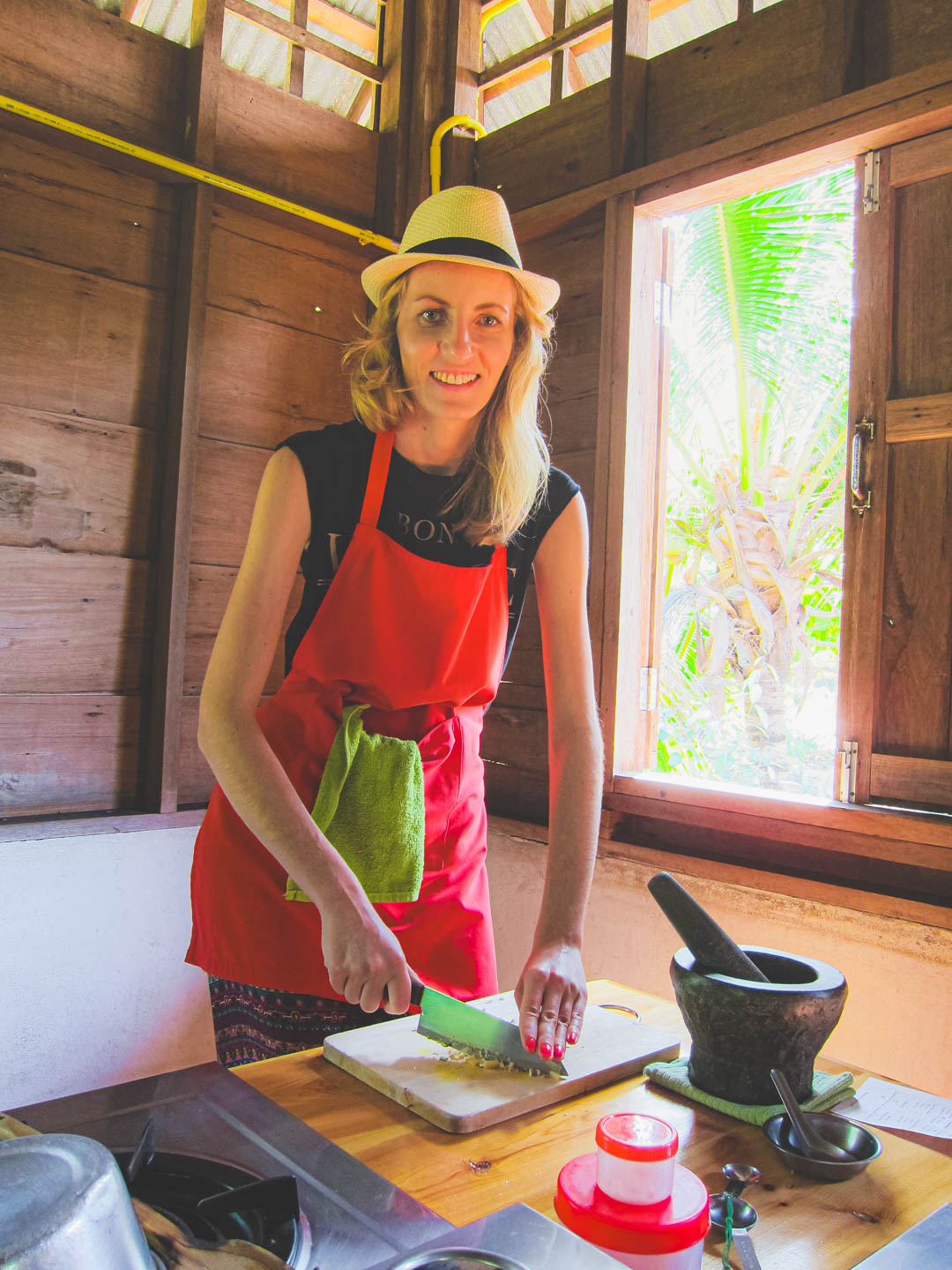
We started with curry paste in the mortar, and let me tell you – my arms got a workout!
There’s something deeply satisfying about pounding spices the traditional way, even though it took me twice as long as everyone else.
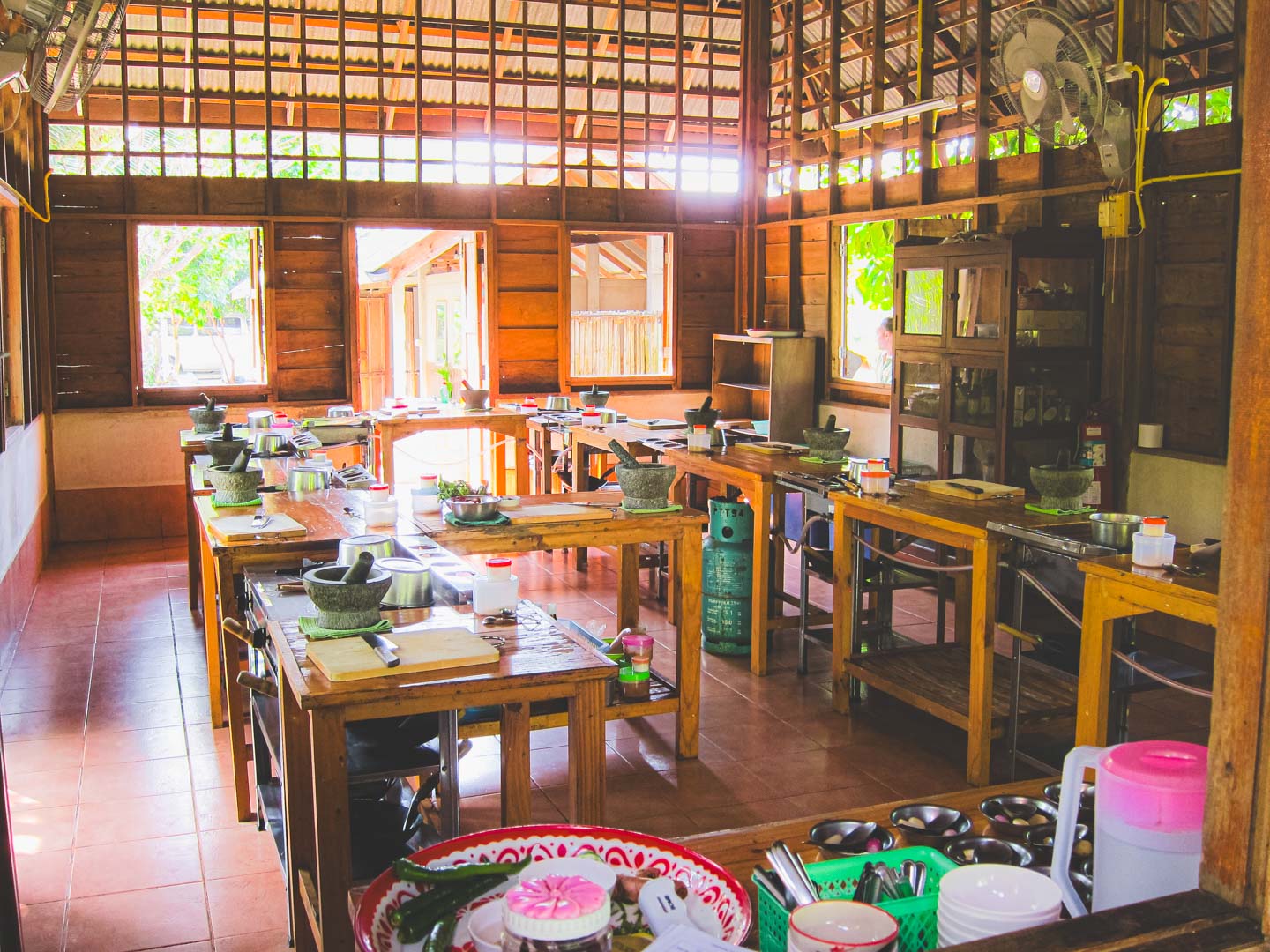
Here’s what we learned to make (and actually succeeded at):
The Curries:
– Red and yellow curry paste (harder than it looks!)
– Chicken curry that actually tasted like restaurant quality
The Soups:
– Tom Yam with shrimp (spicy and perfect)
– Tom Kaa Gai – that creamy coconut soup I’ve been craving since
Stir-fries:
– Chicken with cashew nuts (my new obsession)
– Holy basil chicken that made me understand why Thais are so particular about this herb
The Classics:
– Spring rolls (mine looked wonky but tasted amazing)
– Pad Thai (life-changing moment)
– Mango sticky rice (nearly made me emotional)

My personal highlight was nailing the pad thai.
I’ve ordered it probably a hundred times, but making it myself? Game changer. The balance of sweet, sour, and umami finally made sense.
The mango sticky rice nearly made me emotional.
We’d been eating it all week in Chiang Mai, but understanding how much technique goes into something that seems simple… it gave me a whole new appreciation for Thai desserts.
Let Me Share a Few Recipes That Actually Work
I’m sharing two of my absolute favorite recipes from the class – the ones I make most often at home. But honestly? We learned to make six different dishes, and I use every single recipe regularly.
Thai Basil Chicken (Phad Kaprao Gai) – The One That Converted Me
I thought I didn’t like basil until I tried this dish. Thai holy basil is completely different from Italian basil – more peppery and intense. This became my weeknight go-to.
Here’s what you need:
– 100g minced chicken
– 2 tablespoons oil
– 3 cloves crushed garlic
– 1/3 cup chopped long beans (or green beans)
– 2-3 bird’s eye chilies
– 1 cup holy basil leaves
– 1 tablespoon fish sauce
– 1 tablespoon oyster sauce
– 1/2 teaspoon sugar
– 1/4 cup chopped onion
– 3 tablespoons water
Heat oil in a wok, add garlic, onion, chilies, and chicken. Stir until fragrant and chicken is cooked. Add beans, sauces, sugar, and water. Mix well. Finally, stir in basil leaves. Serve over rice.
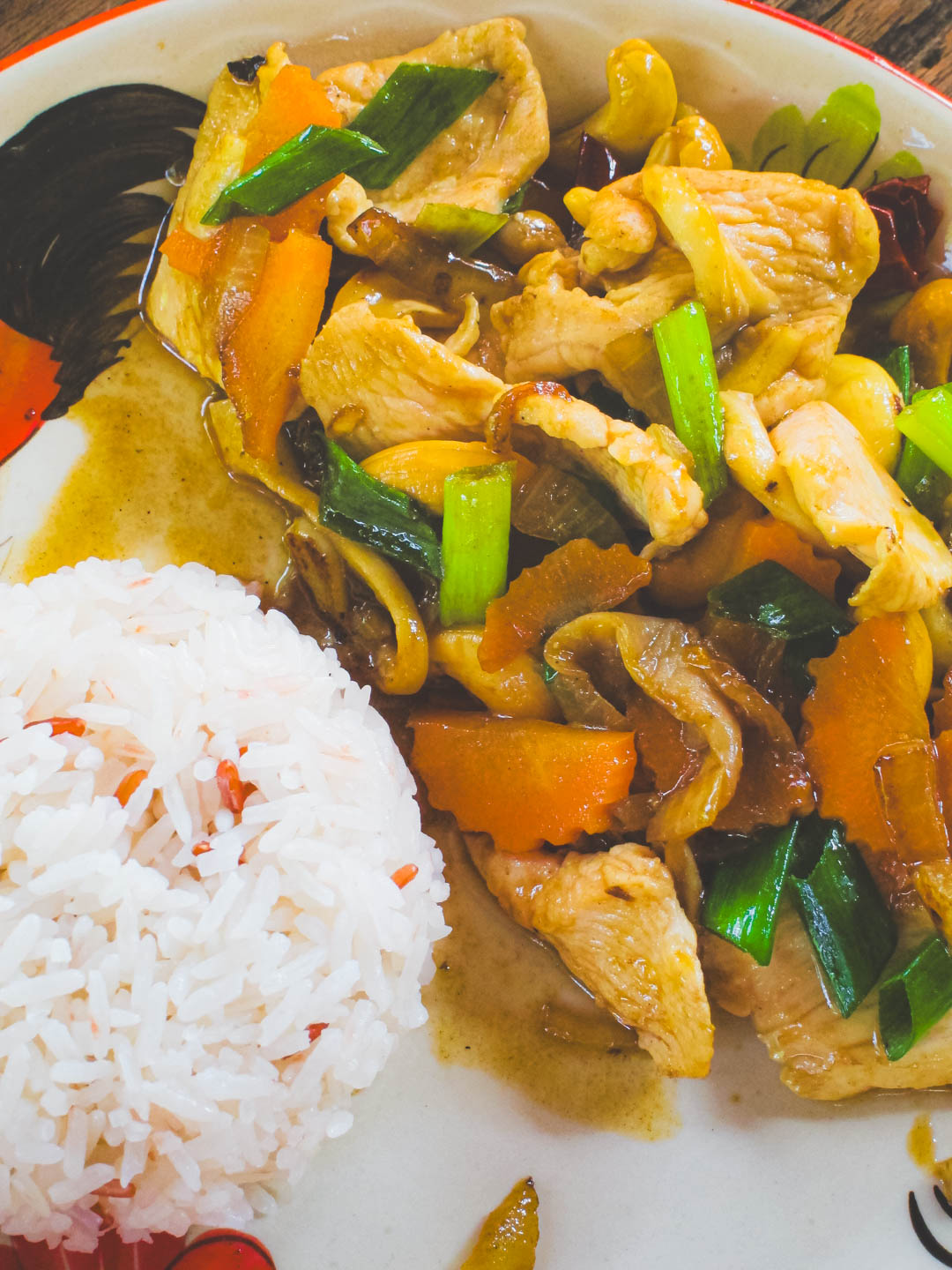
Mango Sticky Rice – The One That Made Me Cry
Okay, this one requires planning because you need to soak the rice overnight. But the payoff…
– Sticky rice (soaked overnight!)
– Coconut milk
– Palm sugar
– Salt
– Ripe mango
Steam the rice, make sweetened coconut sauce, serve with mango. Sounds simple but the technique matters.

Want all 8 recipes from our cooking class?
Including Tom Yum soup, Yellow Curry, Pad Thai, Red Curry, and Spring Rolls – plus my personal cooking tips and secret Chiang Mai spots.
Get the Complete Thai Recipe Collection!
The Best Part: Actually Eating What We Made
Eating our creations on that peaceful terrace was honestly magical. Everything tasted better because we’d made it ourselves – plus, the setting with mountain views didn’t hurt.
I was ridiculously proud of my yellow curry (even though it was a little too spicy – apparently I got carried away with the chilies). My partner’s pad thai was somehow perfect on the first try, which I’m definitely not bitter about at all.
The portions were generous too. We ended up taking containers back to our hotel because there was no way we could finish everything. Having leftover homemade Thai curry for breakfast the next day? No complaints here.
What I loved most was chatting with other travelers while we ate. There’s something about sharing a meal you’ve all cooked together that just brings people together instantly.
Mango sticky rice – the dessert that made me understand why Thais are so good at balancing flavors.
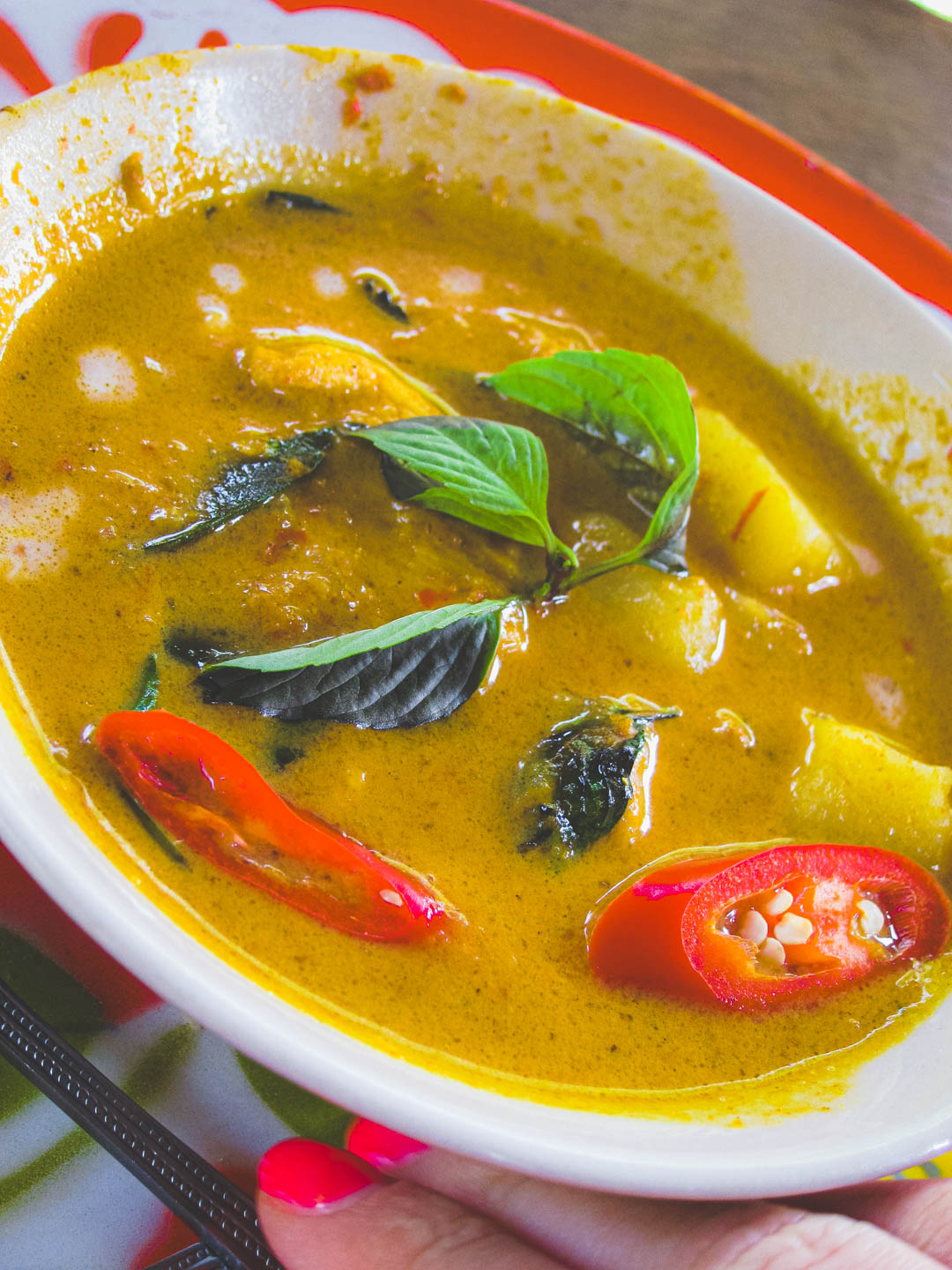
How do you want to explore Thailand?
🗺️ Epic 2-week adventure? → Complete Thailand itinerary
🏙️ Bangkok city vibes? → Local’s guide to the capital
🏖️ Beach paradise? → Perfect Krabi island hopping
🍜 More Thai food culture? → 10 iconic dishes to try
What Thai adventure calls to you?
FAQ: Chiang Mai Cooking Class
How much does a cooking class in Chiang Mai cost?
In 2025, most full-day classes cost between 1,200-1,500 THB ($35-$45 USD).
Thai Farm Cooking School is 1,500 THB, and that includes pickup from your hotel, a market tour, an organic farm visit, cooking six dishes, drinks, and a printed cookbook. No hidden costs – you just show up hungry.
What’s included in a Thai Farm Cooking School class
You get:
- hotel pickup & drop-off,
- a guided market tour (with lots of tasting),
- a walk around the organic farm to pick fresh herbs and veggies,
- hands-on cooking instruction for six dishes,
- all ingredients & drinks,
- a printed cookbook to take home.
Basically, everything except an empty stomach.
Do I need to be good at cooking?
Not at all. Classes are beginner-friendly and you’ll have your own cooking station. The instructors walk you through every step, and you can adjust spice levels to your taste (yes, even “zero chili” is an option).
Was This Cooking Class in Chiang Mai Actually Worth It?
Short answer: absolutely yes.
Longer answer: this wasn’t just about learning recipes. It was about understanding Thai culture through food in a way that felt authentic, not performative.
We’ve already made the yellow curry three times since returning to Poland (yes, we bought a proper mortar and pestle), and every time friends ask for the recipe. The pad thai technique alone was worth the price of admission.
But what I didn’t expect was how much this would change the way I think about travel experiences. Instead of just consuming culture, we got to participate in it. That distinction matters more than I realized.
Plus, having Yummy as our instructor made all the difference. She clearly loves what she does, and that enthusiasm is contagious.
💡 Pro tip: Book in advance during high season (Nov-Feb) – classes fill up fast.
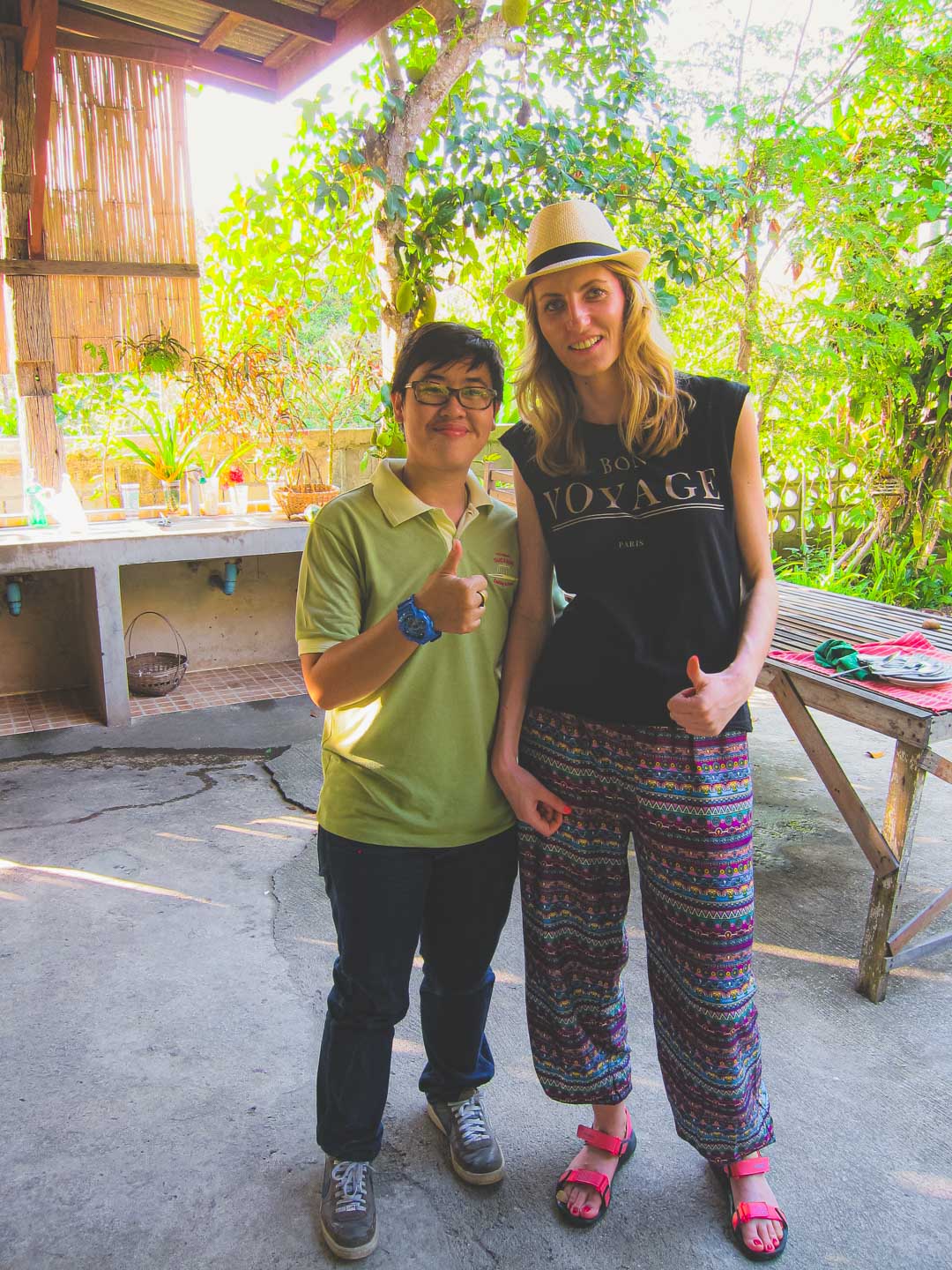
Travel Budget Calculator
Get your free Travel Budget Calculator now and plan your trip without the stress of overspending!
This Cooking Class in Chiang Mai Ruined Restaurant Thai Food for Me (In the Best Way)
I’m not even exaggerating – after understanding how these flavors are built from scratch, ordering pad thai back home just isn’t the same.
We’ve already made the yellow curry three times since returning to Poland, and yes, we bought a proper mortar and pestle.
But beyond the recipes, this experience taught me something about travel that I hadn’t expected. The best cultural experiences aren’t just about seeing or tasting – they’re about understanding.
Learning why Thai cooks balance sweet, sour, salty, and spicy in every dish gave me insight into Thai culture that I never would have gotten just eating amazing food.
If you’re planning a trip to Thailand and wondering whether to book a cooking class, just do it.
Even if you think you can’t cook (like I did), you’ll surprise yourself. And you’ll come home with skills that’ll make your friends very jealous.
Ready for more Thailand adventures?
- The 2-Week Thailand Itinerary You’ll Want to Steal – plan your perfect trip
- 15 AWESOME Things to Do in Bangkok Thailand for First-Timers – urban adventures
- The Only 5-Day Krabi Thailand Itinerary You’ll Ever Need – island paradise
- 10 Iconic Thai Dishes You Can’t Miss – continue your culinary journey

